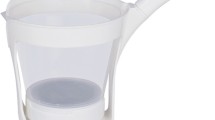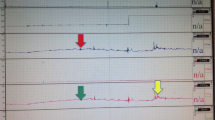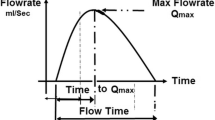Summary
In the evaluation of lower-urinary-tract symptoms, uroflowmetry has played a major role for decades due to its noninvasiveness and simplicity to perform. However, several pitfalls have to be taken into account as mentioned in this review. They include artifacts, circadian changes, observer variation, minimal volume, association with infravesical obstruction, relevant variables, reference values, and clinical applicability. Thus, uroflow should be interpreted with proper caution.
Similar content being viewed by others
References
Abrams PH (1977) Prostatism and prostatectomy: the value of urine flow rate measurement in the preoperative assessment for operation. J Urol 117:70–71
Abrams P (1994) New words for old: lower urinary tract symptoms for “prostatism”. BMJ 308:929–930
Abrams PH, Griffiths DJ (1979) The assessment of prostatic obstruction from urodynamic measurements and from residual urine. Br J Urol 51:129–134
Abrams PH, Farrar DJ, Turner-Warwick RT, Whiteside CG, Feneley RCL (1979) The results of prostatectomy: a symptomatic and urodynamic analysis of 152 patients. J Urol 121:640–642
Chancellor MB, Blaivas JG, Kaplan SA, Axelrod S (1991) Bladder outlet obstruction versus impaired detrusor contractility: the role of uroflow. J Urol 145:810–812
Drach GW, Layton TN, Binard WJ (1979) Male peak urinary flow rate: relationships to volume voided and age. J Urol 122:210–214
Golomb J, Lindner A, Siegel Y, Korczak D (1992) Variability and circadian changes in home uroflowmetry in patients with benign prostatic hyperplasia compared to normal controls. J Urol 147:1044–1047
Grino PB, Bruskewitz R, Blaivas JG, Siroky MB, Andersen JT, Cook T, Stoner E (1993) Maximum urinary flow rate by uroflowmetry: automatic or visual interpretation. J Urol 149:339–341
Jensen KM-E, Jørgensen JB, Mogensen P (1985) Reproducibility of uroflowmetry variables in elderly males. Urol Res 13:237–239
Jensen KM-E, Jørgensen JB, Mogensen P (1988) Urodynamics in prostatism. I. Prognostic value of uroflowmetry. Scand J Urol Nephrol 22:109–117
Jensen KM-E, Jørgensen JB, Mogensen P (1988) Urodynamics in prostatism. II. Prognostic value of pressure-flow study combined with stop-flow test. Scand J Urol Nephrol [Suppl] 114:72–77
Jørgensen JB, Jensen KM-E, Bille-Brahe NE, Mogensen P (1986) Uroflowmetry in asymptomatic elderly males. Br J Urol 58:390–395
Jørgensen JB, Jensen KM-E, Klarskov P, Bernstein I, Abel I, Mogensen P (1990) Intra- and inter-observer variations in classification of urinary flow curve patterns. Neurourol Urodyn 9:535–539
J/orgensen JB, Jensen KM-E, Mogensen P, Klarskov P, Andersen JT (1992) Urinary flow curve patterns and their prognostic value in males over the age of 50 years. Neurourol Urodyn 11:473–481
Jørgensen JB, Mortensen T, Hummelmose T, Sjørslev J (1993) Mechanical versus visual evaluation of urinary flow curves and patterns. Urol Int 51:15–18
Kaufman JJ (1957) A new recording uroflowmeter: a simple automatic device for measuring voiding velocity. J Urol 78:97–102
Klarskov P (1974) Urological diagnosis by investigation of the urinary flow with the Glostrup flowmeter. Ugeslr Laeg 136:2684–2685
Layton TN, Drach GW (1981) Selectivity of peak versus average male urinary flow rates. J Urol 125:839–841
Matzkin H, Zwaag R van der, Chen Y, Patterson LA, Braf Z, Soloway MS (1993) How reliable is a single measurement of urinary flow in the diagnosis of obstruction in benign prostatic hyperplasia? Br J Urol 72:181–186
Meyhoff H-H, Glahn BE (1991) Uroflowmetry. Methods Clin Urodyn 1:2–6
Nishimoto K, Iimori H, Ikemoto S, Hayahara N (1994) Criteria for differentiation of normal and abnormal uroflowmetrograms in adult men. Br J Urol 73:494–497
Rollema HJ (1981) Uroflowmetry in males. Reference values and clinical application in benign prostatic hypertrophy. Drukkerij van Denderen B.V., Groningen
Ryall RL, Marshall VR (1982) Normal peak urinary flow rates obtained from small voided volumes can provide a reliable assessment of bladder function. J Urol 127:484–488
Siroky MB, Olsson CA, Krane RJ (1979) The flow rate nomogram: I. Development. J Urol 122:665–668
Author information
Authors and Affiliations
Rights and permissions
About this article
Cite this article
Jensen, K.M.E. Uroflowmetry in elderly men. World J Urol 13, 21–23 (1995). https://doi.org/10.1007/BF00182661
Issue Date:
DOI: https://doi.org/10.1007/BF00182661




